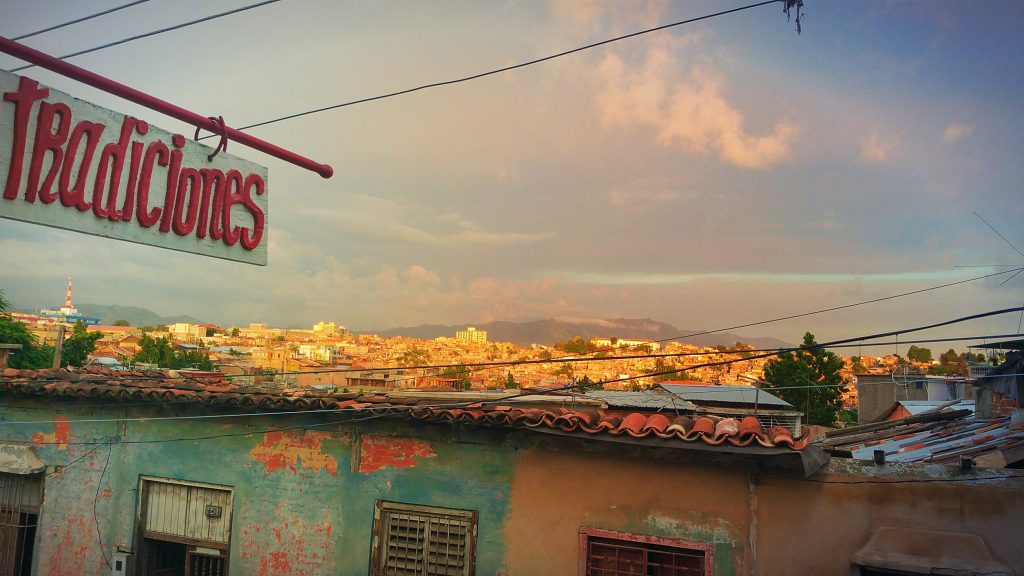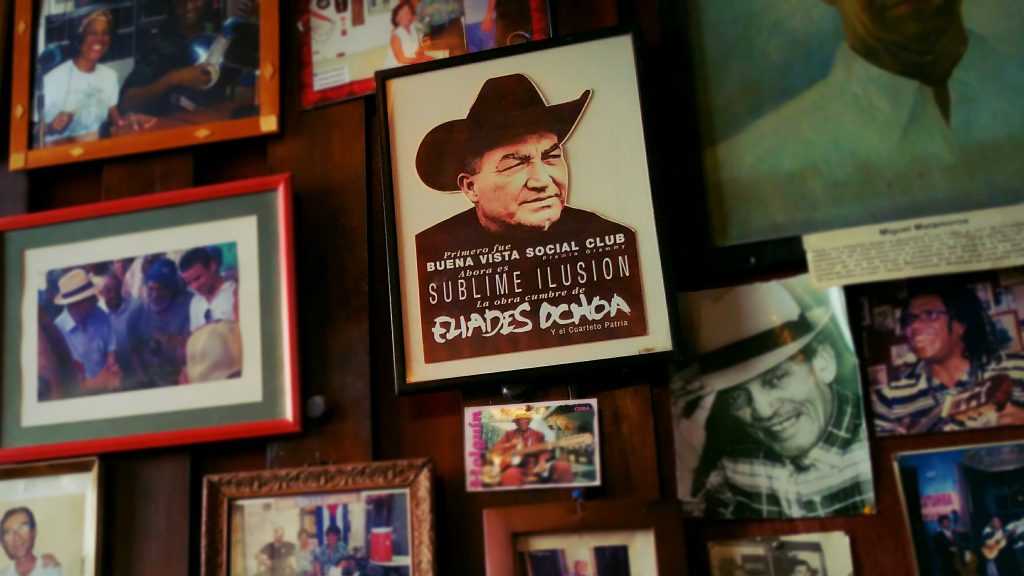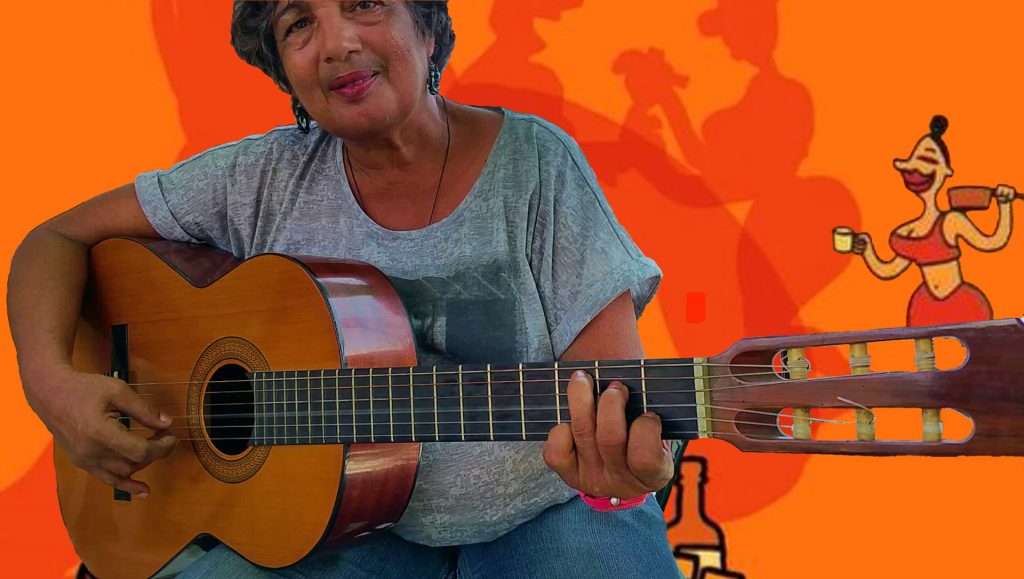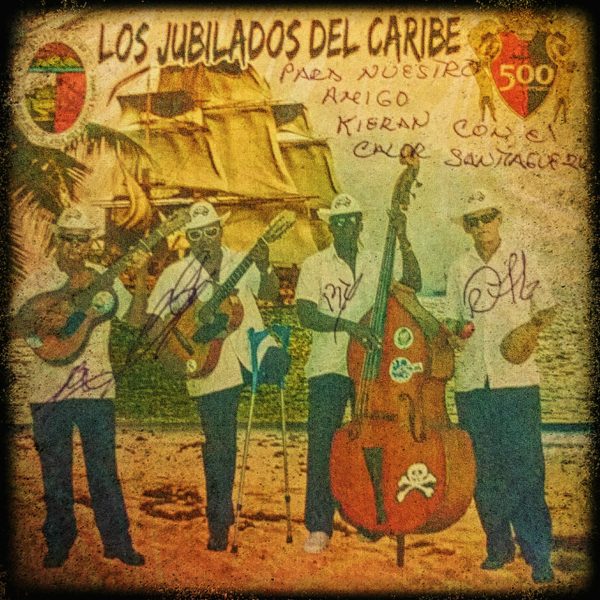Introduction to Bolero with Xiomara Vidal
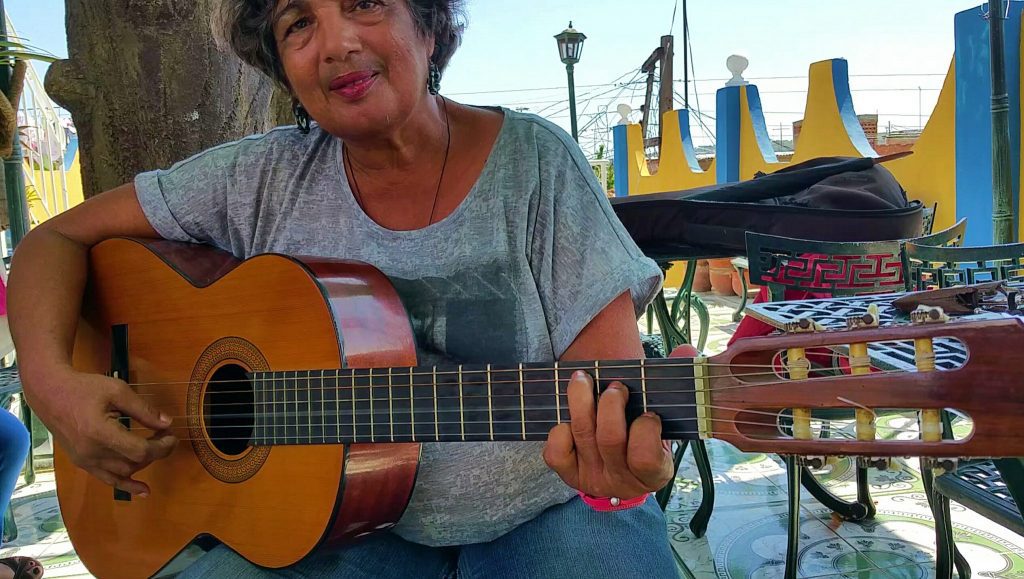
[vc_row][vc_column][vc_column_text]
The day after first meeting trovadora Xiomara Vidal, my new Cuban guitar teacher, I arrive at the Casa del Queso for my first lesson. I’m nervous and excited in equal measure.
What will she have in store for me? How will I manage with the Spanish?
As I enter through the large wooden doors, the atmosphere is subdued, all but for the shuffling of the staff setting up. I spot Xiomara waiting for me in the corner with one of her backing singers. Both rise to their feet, greeting me warmly, and we begin by sharing some nice, strong Cuban coffee.
The conversation turns to my travel-size guitar, which fascinates Xiomara. We discuss its advantages and disadvantages, like a pair of guitar geeks: its portability and sweet tone vs. the drop in power and projection. I mention that I’m looking for a transducer to amplify it in louder situations but I’m not sure how easy these gadgets are to get hold of in Cuba. No sooner than the words have left my lips, Xiomara promises to bring one to the next lesson.
Now it’s time to get down to business. We’ll begin with an introduction to the bolero.
[/vc_column_text][vc_separator color=”green”][/vc_column][/vc_row][vc_row top_margin=”0″ bottom_margin=”0″ css=”.vc_custom_1455062310703{margin-top: -25px !important;}”][vc_column][vc_custom_heading text=”The Cuban Bolero” font_container=”tag:h1|text_align:center” use_theme_fonts=”yes” css=”.vc_custom_1592774096572{margin-top: 0px !important;}”][/vc_column][/vc_row][vc_row][vc_column][vc_column_text]
In general terms, we can think of the bolero as the Latin American equivalent of the ballad, just as we can think of the trovadors who sing them as being equivalent to singer-songwriters. These songs usually have a relaxed tempo with a romantic theme.
However, the first bolero I discovered, specifically tagged as such, was a faster-paced number. It was an interpretation of Django Reinhardt’s, ‘Troublant Bolero’, by a hero of mine, Liverpudlian guitar legend, Gary Potter. This was during my late teens whilst I was learning to play guitar. My uncle, who had taught me how to play, would invite me to jam sessions with his friends. And it was in these formative sessions that I was introduced to jazz guitar and delved deeper into the music of the Beatles.
This early exposure to Latin rhythms and melodies was one of the influences that drew me towards Cuba. And so it’s really something being here in Santiago de Cuba, birthplace of the bolero cubano, learning from someone as steeped in its heritage as Xiomara.
[/vc_column_text][vc_custom_heading text=”Amanecer de Ilusión” font_container=”tag:h1|text_align:center” use_theme_fonts=”yes” css=”.vc_custom_1600816077473{margin-top: 0px !important;}”][vc_column_text]
Xiomara will begin today’s lesson by performing one of her own boleros, ‘Amanecer de Ilusión’ (‘The Dawning of a Dream’). This is one of over 50 boleros that she has written in a career spanning more than 30 years.
She will perform the track for me first and then we can break it down afterwards. Her backing singer is poised, ready to support with vocals whilst playing the claves, a percussion instrument consisting of a pair of short, thick wooden sticks. ‘Clave’ means ‘key’ or ‘code’ and it provides the rhythmic foundation for many Cuban styles.
Here’s Xiomara performing the song solo, during one of our sessions on the roof terrace of Hostal Girasol:
[/vc_column_text][vc_video link=”https://www.youtube.com/watch?v=4na3qIsgdiA”][vc_separator color=”green”][/vc_column][/vc_row][vc_row top_margin=”0″ bottom_margin=”0″ css=”.vc_custom_1455062880789{margin-top: -20px !important;}”][vc_column][vc_custom_heading text=”First Impressions” font_container=”tag:h1|text_align:center” use_theme_fonts=”yes” css=”.vc_custom_1455237943110{margin-top: 0px !important;}”][vc_column_text]
At first glance, the bolero genre seems to be a good place to start my Cuban musical journey. It is gentler and less rhythmically complex than many of the other Cuban styles I’ve heard.
I can’t really grasp the full depth of the lyrics, but Xiomara’s powerful performance is compelling. As she plays, I try to absorb as much as I can, tapping my foot in time to help internalise the rhythm and make a mental note of the musical ingredients.
[/vc_column_text][/vc_column][/vc_row][vc_row][vc_column width=”1/3″][vc_icon icon_fontawesome=”far fa-clock” size=”lg” align=”center”][vc_column_text]
Rhythm
A sedate and stable sequence of notes with many falling on the beat. Some off-beat notes give the pulse a slight lilt.
[/vc_column_text][/vc_column][vc_column width=”1/3″][vc_icon icon_fontawesome=”fas fa-music” size=”lg” align=”center”][vc_column_text]
Melody
Melodies plucked on the high strings, decorating space between lyrics. Deeper bass-runs on the lower strings help connect chords together.
[/vc_column_text][/vc_column][vc_column width=”1/3″][vc_icon icon_fontawesome=”fas fa-yin-yang” size=”lg” align=”center”][vc_column_text]
Harmony
Mainly A-major with a detour in the bridge. Fancy diminished 7th chords make cameo appearances & surprise chords are borrowed from neighbours for a grand finale.
[/vc_column_text][/vc_column][/vc_row][vc_row][vc_column][vc_icon icon_fontawesome=”fas fa-tools” size=”lg” align=”center”][vc_column_text]
Techniques
[/vc_column_text][/vc_column][/vc_row][vc_row][vc_column width=”1/2″ css=”.vc_custom_1455061311248{margin-top: -20px !important;}”][vc_column_text]
Finger-Picking
A mixture of 2 finger-picking styles: the playful finger-style blues, and the more delicate classical guitar style.
[/vc_column_text][/vc_column][vc_column width=”1/2″ css=”.vc_custom_1455061342163{margin-top: -20px !important;}”][vc_column_text]
Strumming
Upward and downward strumming using the pads of the thumb and first finger. Also some downward strumming using the nails, adding a percussive element.
[/vc_column_text][/vc_column][/vc_row][vc_row top_margin=”0″ bottom_margin=”0″ css=”.vc_custom_1455063324145{margin-top: -8px !important;}”][vc_column][vc_separator color=”green”][vc_custom_heading text=”Giving It A Whirl” font_container=”tag:h1|text_align:center” use_theme_fonts=”yes” css=”.vc_custom_1592774289076{margin-top: 0px !important;}”][vc_column_text]
So now it’s time for me to get my hands dirty. We begin by running through the track in sections and Xiomara’s backing singer kindly writes out the chord names.
Cubans, like other latinos, use the Solfège naming system (Do-Re-Mi-Fa-Sol-La-Ti-Do) for their chords and musical notes. So, where I would usually expect to see ‘E-minor‘ or ‘Em‘, instead it is written as ‘Mi-menor‘ or ‘Mi m‘. I’ll just keep my eye on the chord changes instead!
The real challenge is trying to copy her picking patterns and slotting the strumming in between. I decide to focus on getting the timing of the bass notes right and use some familiar picking patterns that will be sympathetic to the style.
Now we set about tackling the song as a whole. It’s a bit of a juggling act but I manage not to drop too many balls. There are some moments where I move to the wrong part of the fretboard so I duck out for a moment, and then back in. Better to play nothing than to play the wrong chord.
And by now, the music has attracted passersby, who are slowly forming a group around us. Xiomara plays to the crowd and invites complements for the rookie gringo’s efforts. So far so good. But we’re only a third of the way through the lesson. Now is no time to take your eye off the ball.
Next, we’ll be looking at a song in the Cuban son style…..
[/vc_column_text][vc_separator color=”green”][/vc_column][/vc_row][vc_row top_margin=”0″ bottom_margin=”0″ css=”.vc_custom_1455074411273{margin-top: 20px !important;background-color: rgba(0,0,0,0.16) !important;*background-color: rgb(0,0,0) !important;border-radius: 3px !important;}”][vc_column][vc_custom_heading text=”Further Listening” font_container=”tag:h1|text_align:center” use_theme_fonts=”yes” css=”.vc_custom_1455066526591{margin-top: 0px !important;}”][/vc_column][vc_column width=”1/2″][vc_column_text]
There is also a Spanish genre named bolero, which predates the Cuban style, but has a different rhythm (with beats grouped in 3s). One of the most famous examples of the Spanish style is Ravel’s ‘Bolero’.
[/vc_column_text][vc_video link=”https://www.youtube.com/watch?v=fTd3ZsvqDiQ”][vc_column_text]
Django Reinhardt is often said to have been influenced by Ravel’s ‘Bolero’ when he wrote ‘Troublant Bolero’ however the rhythm of the track fits much better with the Cuban rhythm (with beats grouped in 4s).
[/vc_column_text][/vc_column][vc_column width=”1/2″][vc_column_text]
Gary Potter is renowned for his seemingly limitless ability to reinvent melodies and re-energise rhythms. Here is his interpretation of ‘Troublant Bolero’.
[/vc_column_text][vc_raw_html]JTNDaWZyYW1lJTIwc3JjJTNEJTIyaHR0cHMlM0ElMkYlMkZlbWJlZC5zcG90aWZ5LmNvbSUyRiUzRnVyaSUzRHNwb3RpZnklMjUzQXRyYWNrJTI1M0EyNk1YbmQ4bk1xQzl6cHpLd0x4UEFoJTIyJTIwd2lkdGglM0QlMjIzMDAlMjIlMjBoZWlnaHQlM0QlMjIzODAlMjIlMjBhbGlnbiUzRCUyMmNlbnRlciUyMiUyMGZyYW1lYm9yZGVyJTNEJTIyMCUyMiUyMGFsbG93dHJhbnNwYXJlbmN5JTNEJTIydHJ1ZSUyMiUzRSUzQyUyRmlmcmFtZSUzRQ==[/vc_raw_html][/vc_column][/vc_row]

